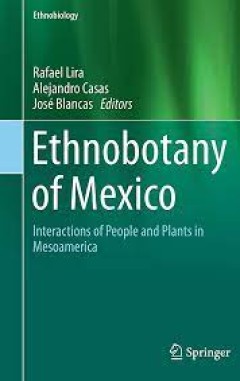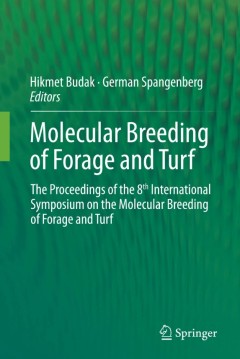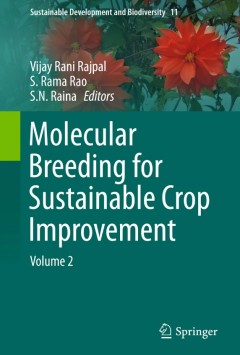Filter by

Legume Nitrogen Fixation in a Changing Environment: Achievements and Challenges
The world population will grow more rapidly during the few coming years. This must be accompanied by a parallel increase in the agricultural production to secure adequate food. Sustainability considerations mandate that alternatives to chemical nitrogen fertilizers must be urgently sought. Biological nitrogen (N2) fixation, a microbiological process which converts atmospheric N2 into a plant-us…
- Edition
- -
- ISBN/ISSN
- 978-3-319-06212-9
- Collation
- -
- Series Title
- -
- Call Number
- -

Grain Legumes
This book is devoted to grain legumes and include eight chapters devoted to the breeding of specific grain legume crops and five general chapters dealing with important topics which are common to most of the species in focus. Soybean is not included in the book as it is commonly considered an oil crop more than a grain legume and is included in the Oil Crops Volume of the Handbook of Plant Bree…
- Edition
- -
- ISBN/ISSN
- 978-1-4939-2796-8
- Collation
- XIX, 438
- Series Title
- -
- Call Number
- 581.5 GRA

Nanotechnology and Plant Sciences: Nanoparticles and Their Impact on Plants
This book presents a holistic view of the complex and dynamic responses of plants to nanoparticles, the signal transduction mechanisms involved, and the regulation of gene expression. Further, it addresses the phytosynthesis of nanoparticles, the role of nanoparticles in the antioxidant systems of plants and agriculture, the beneficial and harmful effects of nanoparticles on plants, and the app…
- Edition
- 1
- ISBN/ISSN
- 978-3-319-36211-3
- Collation
- XII
- Series Title
- -
- Call Number
- -

Molecular Breeding for Sustainable Crop Improvement
The world population is estimated to reach to more than 10 billion by the year 2050. These projections pose a challenging situation for the agricultural scientists to increase crops productivity to meet the growing food demands. The unavailability and/or inaccessibility to appropriate gene pools with desired traits required to carry out genetic improvement of various crop species make th…
- Edition
- 1
- ISBN/ISSN
- 978-3-319-27088-3
- Collation
- XI, 478
- Series Title
- Sustainable Development and Biodiversity
- Call Number
- -

Ethnobotany of Mexico Interactions of People and Plants in Mesoamerica
This book reviews the history, current state of knowledge, and different research approaches and techniques of studies on interactions between humans and plants in an important area of agriculture and ongoing plant domestication: Mesoamerica. Leading scholars and key research groups in Mexico discuss essential topics as well as contributions from international research groups that have conduct…
- Edition
- -
- ISBN/ISSN
- 978-1-4614-6669-7
- Collation
- 21 b/w illustrations, 71 illustrations in colour
- Series Title
- -
- Call Number
- -

The Tomato Genome
This book describes the strategy used for sequencing, assembling and annotating the tomato genome and presents the main characteristics of this sequence with a special focus on repeated sequences and the ancestral polyploidy events. It also includes the chloroplast and mitochondrial genomes. Tomato (Solanum lycopersicum) is a major crop plant as well as a model for fruit development, and the av…
- Edition
- -
- ISBN/ISSN
- 978-3-662-53389-5
- Collation
- -
- Series Title
- -
- Call Number
- -

Molecular Breeding of Forage and Turf
This proceeding covers all the collected research data and presentations from the 8th International Symposium on the Molecular Breeding of Forage and Turf. The book explores themes in molecular breeding of forage and turf, including abiotic and biotic stresses, bioenergy and biorenewables, comparative genomics, emerging tools for forage and turf research, functional genetics and genomics and ge…
- Edition
- 1
- ISBN/ISSN
- 978-3-319-08713-9
- Collation
- XIII, 194
- Series Title
- -
- Call Number
- -

The Sorghum Genome
This book provides insights into the current state of sorghum genomics. It particularly focuses on the tools and strategies employed in genome sequencing and analysis, public and private genomic resources and how all this information is leading to direct outcomes for plant breeders. The advent of affordable whole genome sequencing in combination with existing cereal functional genomics data has…
- Edition
- -
- ISBN/ISSN
- 978-3-319-47789-3
- Collation
- -
- Series Title
- -
- Call Number
- -

Molecular Breeding for Sustainable Crop Improvement
The world population is estimated to reach to more than 10 billion by the year 2050. These projections pose a challenging situation for the agricultural scientists to increase crops productivity to meet the growing food demands. The unavailability and/or inaccessibility to appropriate gene pools with desired traits required to carry out genetic improvement of various crop species make th…
- Edition
- 1
- ISBN/ISSN
- 978-3-319-27088-3
- Collation
- XI, 478
- Series Title
- Sustainable Development and Biodiversity
- Call Number
- -

The Search for Wild Relatives of Cool Season Legumes
The study of origin and domestication of legumes described in this book emerged when it became apparent that while this kind of information is adequate for cereals, the pulses lagged behind. At the end of the 1960s the senior author initiated a study on the chickpea's wild relatives followed by similar attempts for broad bean, fenugreek, common vetch, bitter vetch, and lentil. The junior aut…
- Edition
- -
- ISBN/ISSN
- 978-3-319-14505-1
- Collation
- -
- Series Title
- -
- Call Number
- -
 Computer Science, Information & General Works
Computer Science, Information & General Works  Philosophy & Psychology
Philosophy & Psychology  Religion
Religion  Social Sciences
Social Sciences  Language
Language  Pure Science
Pure Science  Applied Sciences
Applied Sciences  Art & Recreation
Art & Recreation  Literature
Literature  History & Geography
History & Geography